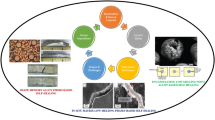Abstract
Technology for producing hybrid nanocomposite materials with a 7075-T6 aluminum matrix and a filler in the form of nanoparticles is proposed. A review of experimental data and computer and theoretical models of crack initiation is presented. The mechanisms of microcrack initiation under uniaxial tensile load are determined. To study the fracture of loaded nanocrystalline materials and determine their mechanisms, a model is proposed that describes the formation and growth of nanocracks near the tips of elliptical cracks in a hybrid nanocomposite material. The dependences between the applied force and the crack length are obtained using the parameters of a modeled crack.




Similar content being viewed by others
REFERENCES
D. Wolf, V. Yamakov, S. R. Phillpot, et al., “Deformation of Nanocrystalline Materials by Molecular-Dynamics Simulation: Relationship to Experiments," Acta Mater. 53 (1), 1–40 (2005).
K. A. Padmanabhan and H. Gleiter, “Optimal Structural Superplasticity in Metals and Ceramics of Microcrystalline- and Nanocrystalline-Grain Sizes," Mater. Sci. Eng. A 381 (1), 28–38 (2004).
K. S. Kumar, S. Suresh, M. F. Chisholm, et al., “Deformation of Electrodeposited Nanocrystalline Nickel," Acta Mater. 51 (2), 387–405 (2003).
I. Hasanov, I. Abbasov, and N. Gurbanov, “‘Stress-Deformed State of a Packing Ring with Eccentric Holes," Proc. Latvian Acad. Sci. Sec. B 74 (4), 287–292 (2020).
T. G. Jabbarov, O. A. Dyshin, M. B. Babanli, et al., “Mathematical Modeling of the Sintering Process of Iron-Based Metal–Glass Materials," Progr. Phys. Met. 20 (4), 584 (2019).
N. A. Gurbanov and M. B. Babanli, “Investigation of Effects of Graphene Nanoplatelets Addition on Mechanical Properties of 7075-T6 Aluminium Matrix Hybrid Fibre Metal Laminates," Metallophys. Adv. Technol. 43 (12), 1589–1599 (2021).
D. Farkas, S. Petegem, P. M. Derlet, and Van H. Swygenhoven, “Dislocation Activity and Nano-Void Formation near Crack Tips in Nanocrystalline Ni," Acta Mater. 53 (11), 3115–3123 (2005).
M. J. Demkowicz, A. S. Argon, D. Farkas, and M. Frary, “Simulation of Plasticity in Nanocrystalline Silicon," Philos. Mag. 87, 4253–4271 (2007).
A. Afrouzian, H. M. Aleni, G. Liaghat, and H. Ahmad, “Effect of Nano-Particles on the Tension, Flexural and Perforation Properties of the Glass/Epoxy Composites," J. Reinforc. Plast. Compos. 36 (12), 900–916 (2017).
D. M. Hulbert, D.Jiang D., J. D. Kuntz, et al., “A Low-Temperature High-Strain-Rate Formable Nanocrystalline Superplastic Ceramic," Scripta Mater. 56 (12), 1103–1106 (2007).
I. A. Ovid’ko and A. G. Sheinerman, “Nanocrack Generation at Dislocation–Disclination Configurations in Nanocrystalline Metals and Ceramics," Phys. Rev. B 77, 54109 (2008)
T. Mura, Micromechanics of Defects in Solids (Martinus Nijhoff, Dordrecht, 1987).
S. V. Bobylev, A. K. Mukherjee, I. A. Ovid’ko, et al., “Effects of Intergrain Sliding on Crack Growth in Nanocrystalline Materials," Int. J. Plasticity 26 (11), 1629–1644 (2010).
L. L. Fischer and G. E. Beltz, “The Effect of Crack Blunting on the Competition between Dislocation Initiation and Cleavage," J. Mech. Phys. Solids 49, 635–654 (2001).
G. E. Beltz, D. M. Lipkin, and L. L. Fischer, “Role of Crack Blunting in Ductile versus Brittle Response of Crystalline Materials," Phys. Rev. Lett. 82, 44–68 (1999).
I. A. Ovid’ko and A. G. Sheinerman, “Ductile vs. Brittle Behavior of Pre-Cracked Nanocrystalline and Ultrafine-Grained Materials," Acta Mater. 58 (16), 5286–5294 (2010).
D. Farkas and W. A. Curtin, “Plastic Deformation Mechanisms in Nanocrystalline Columnar Grain Structures," Mater. Sci. Eng. A 412 (1), 316–322 (2005).
I. A. Ovid’ko and A. G. Sheinerman, “Grain Boundary Sliding and Nanocrack Generation near Crack Tips in Nanocrystalline Metals and Ceramics," Mater. Phys. Mech. 10, 37–46 (2010).
V. M. Mirsalimov, “Optimal Design of a Composite Reinforced by Unidirectional Fibers," Prikl. Mekh. Tekh. Fiz. 61 (3), 153–170 (2020) [J. Appl. Mech. Tech. Phys. 61 (3), 447–462 (2020); https://doi.org/10.1134/S0021894420030177].
V. M. Mirsalimov, “Contact Problem of a Periodic System of Variable Width Slits with Partially Interacting Edges in the Presence of End Zones of Plastic Deformations," Prikl. Mekh. Tekh. Fiz. 60 (1), 114–123 (2019) [J. Appl. Mech. Tech. Phys. 60 (1), 97–105 (2019); https://doi.org/10.1134/S0021894419010139].
Author information
Authors and Affiliations
Corresponding author
Additional information
Translated from Prikladnaya Mekhanika i Tekhnicheskaya Fizika, 2022, Vol. 63, No. 5, pp. 168-177. https://doi.org/10.15372/PMTF20220517.
Rights and permissions
About this article
Cite this article
Babanli, M., Mekhtiyev, R., Gurbanov, N. et al. CRACKS IN HYBRID FIBER METAL LAMINATED NANOCOMPOSITES UNDER UNIAXIAL TENSION. J Appl Mech Tech Phy 63, 876–883 (2022). https://doi.org/10.1134/S0021894422050170
Received:
Revised:
Accepted:
Published:
Issue Date:
DOI: https://doi.org/10.1134/S0021894422050170




